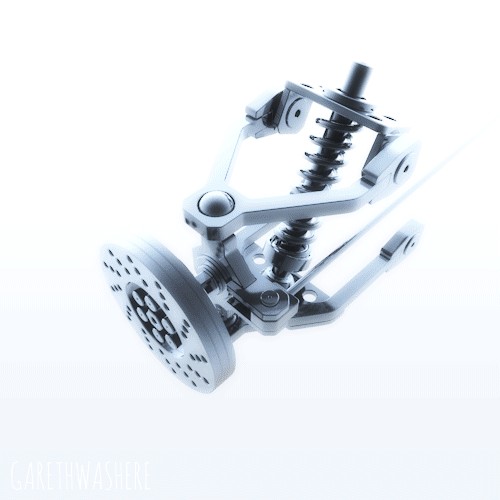Wishbones, also known as control arms, are fundamental components of your car’s suspension system. They play a crucial role in ensuring a smooth, stable, and safe driving experience.
Decoding the Wishbone: More Than Just a Bone-Shaped Part
Often referred to as wishbones due to their triangular or A-shape resembling a bird’s wishbone, these parts are more technically known as control arms. Regardless of the name, their function is critical to the operation of your vehicle’s suspension.
 Wishbones on a car
Wishbones on a car
An illustration depicting the typical shape and positioning of wishbone car parts within a vehicle’s suspension system.
The Vital Role of Wishbones in Car Suspension
So, what do wishbones do on a car? The primary function of wishbones is to connect the vehicle’s wheel hub and steering knuckle to the chassis or vehicle frame. This connection is not rigid; instead, wishbones are designed to allow controlled movement. They facilitate the wheel’s vertical motion in response to road irregularities, effectively absorbing shocks and bumps.
Wishbones work in harmony with other suspension components like shock absorbers and drive shafts. They allow the entire wheel assembly to move up and down while maintaining wheel alignment and stability. This ensures consistent tire contact with the road surface, which is paramount for:
- Handling: Precise steering and responsiveness.
- Stability: Maintaining control during acceleration, braking, and cornering.
- Ride Comfort: Minimizing vibrations and harshness felt by passengers.
Recognizing Signs of Wishbone Wear and Tear
A failing wishbone can significantly compromise your vehicle’s handling and safety. Be alert for these common symptoms indicating potential wishbone issues:
- Poor Handling: Vague or unresponsive steering, difficulty maintaining a straight line.
- Vehicle Pulling to One Side: Especially noticeable during acceleration or braking, suggesting uneven suspension forces.
- Unusual Noises: Clunking or knocking sounds, particularly when driving over bumps or turning, indicating worn bushings or ball joints within the wishbone assembly.
- Uneven Tire Wear: Premature or irregular wear patterns on tires can be a sign of suspension misalignment caused by wishbone problems.
- Visible Damage: During a visual inspection, look for bent or cracked wishbones, damaged bushings (cracked or excessively worn rubber), and leaking or damaged ball joints.
If you experience any of these symptoms, it’s crucial to have your vehicle inspected by a qualified mechanic to determine if wishbone replacement is necessary.
Wishbone Replacement: Ensuring Safety and Performance
Car wishbone replacement cost can vary depending on factors like vehicle make and model, the type of wishbone, and labor costs. It’s always recommended to consult with a trusted local garage or dealership for a professional assessment and accurate quote.
While cost is a factor, prioritizing quality and safety is paramount. At [Your Website Name – e.g., CarDiagXpert], we understand the importance of reliable suspension components. We offer a comprehensive range of wishbones manufactured to the highest standards, using materials like:
- Steel: Known for its strength and durability, commonly used in wishbone construction.
- Cast Iron: Provides robust performance and is often chosen for specific vehicle applications.
- Alloy: Offers a balance of strength and weight reduction in some designs.
When selecting a replacement wishbone, consider these key specifications to ensure compatibility with your vehicle:
- Material: Steel, Cast Iron, or Alloy, depending on the original specification and desired performance.
- Ball Joint: Ensure the inclusion and type of ball joint matches your vehicle’s requirements. Ball joints are flexible connectors linking the wishbone to the wheel assembly.
- Mounting Bush: Check the type and location of mounting bushes. These flexible bushings connect the wishbone to the vehicle frame, absorbing vibrations and allowing movement. Look for Rear Mounting Bush or Front Mounting Bush specifications.
- Position: Identify whether you need a wishbone for the Front of Wheel or Rear of Wheel position, as vehicle suspensions can utilize different configurations.
- Duty Rating: For Light Commercial Vehicles (LCV), consider Standard Duty for normal use or Heavy Duty for vehicles subjected to more demanding loads.
- Chassis Number Compatibility: Pay attention to chassis number ranges ((->ch.12335) / (ch.12345->)) to ensure compatibility with specific production batches of your vehicle.
- Engine Type Compatibility: In some cases, wishbone selection might be related to Engine Type (Eng.CJCA), so verify this specification if indicated.
To find the correct wishbones and control arms for your specific vehicle, we encourage you to use our part finder tool. Simply enter your registration number or vehicle details in the part finder located at the top of our page. This will help you quickly and accurately identify the wishbones that are perfectly matched to your car, ensuring optimal performance, safety, and driving comfort.